Book contents
- Emergency Airway ManagementSecond Edition
- Emergency Airway Management
- Copyright page
- Contents
- Contributors
- Foreword
- Note
- Glossary
- Chapter 1 Introduction
- Chapter 2 Delivery of oxygen
- Chapter 3 Basic airway management
- Chapter 4 Indications for intubation
- Chapter 5 Airway assessment
- Chapter 6 Preparation for rapid sequence induction
- Chapter 7 Pharmacology of emergency airway drugs
- Chapter 8 Rapid sequence induction and tracheal intubation
- Chapter 9 Difficult and failed airway
- Chapter 10 Post-intubation management
- Chapter 11 Emergency airway management in special circumstances
- Objectives
- Introduction
- Special considerations in children
- Equipment
- RSI technique in children
- Ventilators
- The difficult airway in children
- Summary
- Objectives
- Introduction
- Airway
- Cervical spine management
- Rapid sequence induction in trauma and traumatic brain injury
- Breathing
- Circulation
- Neurological injury
- Post-intubation management
- The agitated patient
- Summary
- Acknowledgement
- Objective
- Introduction
- Respiratory emergencies
- Cardiovascular emergencies
- Sepsis
- Anaphylaxis and angio-oedema
- Summary
- Acknowledgement
- Objectives
- Introduction
- Risks to the comatose or convulsing patient
- Immediate treatment principles
- Indications for intubation in the non-traumatic coma or convulsing patient
- The technique of tracheal intubation
- Pitfalls
- Summary
- Acknowledgement
- Objectives
- Background
- Pre-hospital rapid sequence induction in an emergency medical service
- Indications
- Principles
- Technique
- Summary
- Acknowledgement
- Objectives
- Introduction
- Special considerations in the obstetric patient
- Rapid sequence induction and tracheal intubation
- Failed intubation and failed ventilation
- Pre-eclampsia
- Training
- Summary
- 11.1 Paediatrics
- 11.2 Major trauma and raised intracranial pressure
- 11.3 Cardiorespiratory failure
- 11.4 Non-traumatic coma and seizures
- 11.5 Pre-hospital care
- 11.6 The pregnant patient
- Chapter 12 Non-invasive ventilatory support
- Chapter 13 Human factors, audit and skills maintenance
- Book part
- Index
- References
11.2 - Major trauma and raised intracranial pressure
from Chapter 11 - Emergency airway management in special circumstances
Published online by Cambridge University Press: 05 April 2015
- Emergency Airway ManagementSecond Edition
- Emergency Airway Management
- Copyright page
- Contents
- Contributors
- Foreword
- Note
- Glossary
- Chapter 1 Introduction
- Chapter 2 Delivery of oxygen
- Chapter 3 Basic airway management
- Chapter 4 Indications for intubation
- Chapter 5 Airway assessment
- Chapter 6 Preparation for rapid sequence induction
- Chapter 7 Pharmacology of emergency airway drugs
- Chapter 8 Rapid sequence induction and tracheal intubation
- Chapter 9 Difficult and failed airway
- Chapter 10 Post-intubation management
- Chapter 11 Emergency airway management in special circumstances
- Objectives
- Introduction
- Special considerations in children
- Equipment
- RSI technique in children
- Ventilators
- The difficult airway in children
- Summary
- Objectives
- Introduction
- Airway
- Cervical spine management
- Rapid sequence induction in trauma and traumatic brain injury
- Breathing
- Circulation
- Neurological injury
- Post-intubation management
- The agitated patient
- Summary
- Acknowledgement
- Objective
- Introduction
- Respiratory emergencies
- Cardiovascular emergencies
- Sepsis
- Anaphylaxis and angio-oedema
- Summary
- Acknowledgement
- Objectives
- Introduction
- Risks to the comatose or convulsing patient
- Immediate treatment principles
- Indications for intubation in the non-traumatic coma or convulsing patient
- The technique of tracheal intubation
- Pitfalls
- Summary
- Acknowledgement
- Objectives
- Background
- Pre-hospital rapid sequence induction in an emergency medical service
- Indications
- Principles
- Technique
- Summary
- Acknowledgement
- Objectives
- Introduction
- Special considerations in the obstetric patient
- Rapid sequence induction and tracheal intubation
- Failed intubation and failed ventilation
- Pre-eclampsia
- Training
- Summary
- 11.1 Paediatrics
- 11.2 Major trauma and raised intracranial pressure
- 11.3 Cardiorespiratory failure
- 11.4 Non-traumatic coma and seizures
- 11.5 Pre-hospital care
- 11.6 The pregnant patient
- Chapter 12 Non-invasive ventilatory support
- Chapter 13 Human factors, audit and skills maintenance
- Book part
- Index
- References
- Type
- Chapter
- Information
- Emergency Airway Management , pp. 131 - 139Publisher: Cambridge University PressPrint publication year: 2015

